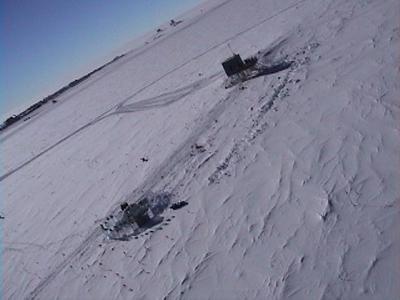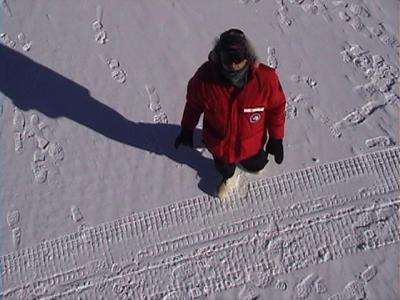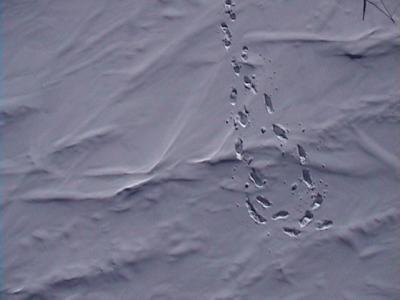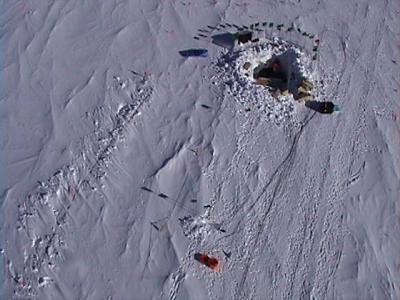12 December, 2002
12 December, 2002
I had a very busy day today. The usual: up at 4 to start uploading
movies, pictures, and journals.
Then, I wrote an arcticle about 2 of the scientists I've met for the
Antarctic Sun, a weekly newspaper put out by the National Science
Foundation at McMurdo. The Sun features a lot of excellent science
writing, and they maintain a great web presence. Check it out at
http://www.polar.org/antsun/Sun120802/index.html
We had a fire under the dome. No big deal, just a stuck washing
machine belt got hot and rubbery and set of a detector. But think
about it : fire here is very bad, for a number of reasons. I was very
impressed to see how quickly the fire crew got on it. It only took
seconds.
Then, off to the store, where I spent every last nickel of US money
on shirts and postcards.
Then Phillipe & Julia & I hiked over to MAPO, and ran the last set of
calibration tests on the AMANDA detector. Modern physics is as much
about understanding your machine as it is about understanding the
thing you¸re studying. This was a case in point. In order to detect
neutrinos, you need to know precisely when each of the individual
detectors in the array was "hit." So precisely, in fact, that if
anything is changed in the detector, a wire, an amplifier, that may
change or delay the signal time. So all those delays have to be
measured and calibrated, so that when you get a real hit, you can
know what it means. But calibrations, while crucial and necessary,
are rather tedious. I made a time lapse movie of the process. It's
funny, because not much happens.
Then, lunch.
Then, kite flying. I only had to use one kite, for the first time
here. The wind picked up and it was really cold, and I almost killed
my camcorder. A tape got jammed, and I had to reset the processor.
Then, dinner.
Then Robert, one of the winterovers, & I tried to fly his stunt kites
at the pole. Great photo opp. No wind.
It was a bust.
Tomorrow, I'll stream live audio & video into my physics classes at
Roosevelt using Apple Computer¸s QuickTime Streaming Server software.
This was a bear to figure out, but we've tested it & think it will
work (I waved to my wife in Seattle on Sunday). It should be fun :
each webcast, I'll feature a different scientist talking about their
work.
To make period one, which starts at 7:45 am in Seattle, I'll need to
get moving at 3 am. No problem, it's always daytime.

I've discussed talked a lot about AMANDA, the Antarctic Muon & Neutrino Detector Array I cam down here to work on. Well, except for the electronics in the lab, AMANDA is buried 2 km deep in the ice. So what's to see ? Nothing ! Here's a kite aerial photograph of one of the melt holes. I gave the physicists a bad time about this: "If people are ever going to get behind your project, you're going to have to give them something better to look at than this !"

An aerial view of the SPASE (South Pole Air Shower Experiment) I've helped Bai with. The little blue building holds all the electronics. It's crowded with 2 people in it. In front, with the flags around it, is the pit with the ice tank muon detector that's given us such fits.

Your intrepid hero, flying kites at windchill : -45 C. It was really cold and somewhat more windy, and I almost killed my camcorder today.

Those are my footsteps. Am I making progress ?

Bai is working on an experiment to detect horizontal muons. Muons are secondary parcticles created when energetic parcticles enter the earth's atmosphere. Most are vertical, so the horizontal rate is quite low. The SPASE array uses scintillator detectors in brightly colored orange boxes. A pair of these is to the lower left, and another pair is inside at the far end of the pit. The chance of a muon passing through all 4 scintillators is quite low, so this experiment will probably run until just before Bai leaves the Pole on the 23rd of December.

A kite aerial photograph of the Martin A Pomerantz Observatory building. The South Pole is one of the world's great observatories. It's remote, and really cold, but the air is cleaner and dryer than just about anywhere else on Earth. The AMANDA lab is in the 2nd floor of this building.
Contact the TEA in the field at
.
If you cannot connect through your browser, copy the
TEA's e-mail address in the "To:" line of
your favorite e-mail package.
|
